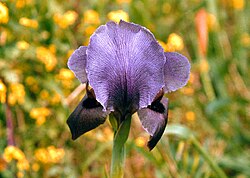Mount Gilboa
| Mount Gilboa | |
|---|---|
 Mount Gilboa, 2007 | |
| Highest point | |
| Elevation | 496 m (1,627 ft) |
| Coordinates | 32°26′02″N 35°24′52″E / 32.43389°N 35.41444°E |
| Geography | |
| Location | Northern District, Israel |
| Parent range | Samaria |

Mount Gilboa (Hebrew: הַר הַגִּלְבֹּעַ, romanized: Har hagGīlbōaʿ; Arabic: جبل جلبوع Jabal Jalbūʿ or جبل فقوعة Jabal Fuqqāʿa), sometimes referred to as the Mountains of Gilboa, is the name for a mountain range in Israel. It overlooks the Harod Valley (the eastern part of the larger Jezreel Valley) to the north, and the Jordan Valley and Hills to the southeast to the west, respectively.
Etymology
Gilboa
The meaning of the Hebrew name "Gilboa" is unknown.[1] It is possible that it originates from a former, non-Semitic toponym, where gil referred to "mountain," the second part consisting of an unknown element.[2]
In the Bible
In the Hebrew Bible, Saul, Israel's first king, led a charge against the Philistines at Mount Gilboa (1 Samuel 28:4).[3] The battle ends with the king falling on his own sword and Saul's sons, Jonathan, Abinadab, and Melchishua being killed in battle (1 Samuel 31:1–4). King David, who hears about the tragedy after the battle, curses the mountain:
- Ye mountains of Gilboa, let there be no dew nor rain upon you, neither fields of choice fruits; for there the shield of the mighty was vilely cast away, the shield of Saul, anointed with oil (2 Samuel 1:21).
History
A minor battle between the army of the Crusader Kingdom of Jerusalem and Sultan Saladin took place at the foot of Mount Gilboa in 1183.
The 1260 Battle of Ain Jalut was fought at the foot of Mount Gilboa. The success of the Muslim Mamluks against the Mongols marked the end of the westward push of the Asian empire and ensured the survival of Muslim Egypt.
Geography
The formation has the shape of a boomerang, extending north from the highlands of Samaria on the West Bank and turning northwest at about half its length, thus separating the southeastern end of the Jezreel Valley to the west, from the Beit She'an and Ein Harod valleys to the east. The range's highest peak rises 496 meters above sea level.[citation needed]
Flora and fauna

In 1976 and 1977, Mount Gilboa was counted to have about 170 plant species, including Pinus halepensis (on the rocky slopes) and Pistacia lentiscus (the shrub layer).[4]
Every year from late February until late March the purple Hayne's Iris, known in Hebrew as the Gilboa Iris (Irus ha-Gilboa), blooms on the mountain.[5] Two nature reserves have been declared on the ridge: the Gilboa Iris nature reserve in 1970, covering 7,280 dunams (728 ha), and the eastern Gilboa reserve in 2005, covering 18,290 dunams (1,829 ha).[6]
It also has a very diverse animal species range, with 14 reptile, 7 rodent, 31 bird and 13 isopod species.[7]
See also
- Gideon and Well of Harod
- Gilboa Regional Council
- Ma'ale Gilboa – a religious kibbutz on Mount Gilboa
- Malkishua – a drug rehabilitation centre on Mount Gilboa
- Meirav – a religious kibbutz on Mount Gilboa
References
- ^ The Brown-Driver-Briggs Hebrew and English Lexicon (London: Oxford University Press, 1962), 162.
- ^ Pauli Rahkonen, "A Study on Some Semitic Toponymic Types of the Second Millennium BC in the Southern Levant," Finnish Oriental Society 4 (2016), 121.
- ^ Julie Baretz The Bible on Location: Off the Beaten Path in Ancient and Modern Israel, p. 78, at Google Books
- ^ G. M. Woodwell The Earth in Transition: Patterns and Processes of Biotic Impoverishment (1990), p. 287, at Google Books
- ^ Samantha Wilson, Israel, p. 203, at Google Books
- ^ "List of National Parks and Nature Reserves" (PDF) (in Hebrew). Israel Nature and Parks Authority. Archived from the original (PDF) on 2009-10-07. Retrieved 2010-09-27.
- ^ Zev Nave Transdisciplinary Challenges in Landscape Ecology and Restoration Ecology, an Anthology (2007), p. 148, at Google Books

